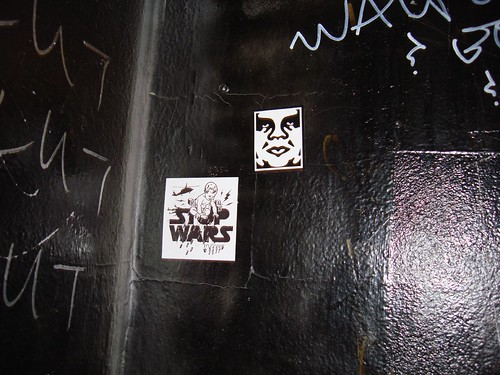Painting your stencil is the final step. You've done all the work to create your stencil and now it's time to put it somewhere for display. Depending on your project, there are a couple of different application methods and an unlimited amount of surfaces for you to paint. Generally, your surface needs to be generally smooth or your stencil is not going to turn out how you want it.
If you're painting your walls in your house with decorative stencils or quotes, you'll want to use a small paint roller (like a 3 inch trim roller) and a bucket of paint in a tray. Using spray paint in your house or apartment is not something I would advise.
If you're working with canvas, cardboard, concrete, metal, wood, etc; you'll want to take it outside or in a well ventilated garage (or art studio) and use spray paint. If you're outside, pay attention to the wind and get your can closer if there's a breeze.
Cover your mouth and nose and wear rubber gloves. You might get some paint on your arms.
Mount your stencils to the surface being painted with a light mist of spray adhesive. Don't spray too much glue on it. If you're doing multiple layers, I would advise not using adhesive after the first layer.
Use flat spray paint, don't use glossy spray paint. Don’t let wet paint dry up on the stencil, you can lay it on some newspaper and wipe it off with a paper towel. Be careful not to tear it. One thing you can do is put one hand down on the stencil and peel it off with the other hand, being careful not to let the stencil slide and smudge your design. The best paint to buy is Montana Gold, but any rattle can of Krylon or Rustoleum will work as well.
If you’re doing multiple layers let each color dry before you start on the next one, otherwise you're going to smudge the wet layer. Depending on conditions, this could take 20 minutes or it could take an hour or longer. It's important not to get impatient or you will wreck your picture and possibly have to re-do the entire design. Find something to do while you wait for it to dry. Each layer will take a bit longer because the paint underneath it will become wet as the layer on top of it is applied.
In general, I think it's better to underspray your designs. Too much overspray or getting too thick with your spray paint doesn't look very good in my opinion. You might have a different opinion and you're entitled to it.
Tuesday, December 27, 2011
Thursday, December 22, 2011
Copyright
I'm no lawyer, nor am I a copyright lawyer. That said, I am in no way qualified to give legal advice, but this topic is something that should at least be touched on.
If you are planning to sell a stencil or a painting made from a stencil you've made, make sure you have the rights to use the picture you made your stencil from. Even selling a drawing based on a photograph which you do not have rights to use can get you into hot water if it's not in the public domain. Even if a photograph is in the public domain, if it has an identifiable person in it you need to get permission. There are publicity and privacy rights that are separate from copyright.
There are a few websites out there with good information regarding copyright and public domain works. Public domain sherpa is a good one I suggest you look at.
If you are planning to sell a stencil or a painting made from a stencil you've made, make sure you have the rights to use the picture you made your stencil from. Even selling a drawing based on a photograph which you do not have rights to use can get you into hot water if it's not in the public domain. Even if a photograph is in the public domain, if it has an identifiable person in it you need to get permission. There are publicity and privacy rights that are separate from copyright.
There are a few websites out there with good information regarding copyright and public domain works. Public domain sherpa is a good one I suggest you look at.
Labels:
copyright,
graffiti,
lawsuit,
Stencil,
street art
Sunday, November 27, 2011
Going Big
 |
| Lining up islands |
When it comes to most things, bigger is often better. A big billboard is way more visible to more people from further away. So why not go big with your stencil?
Print your outline out and fit it to 1x2, 2x1, or 2x2 pages (or bigger if you're so inclined.) You will need to pay special attention to any islands that spill over from one page to another. Unless you're leaving a margin on each page, you'll want to line edges of the outline up to the end of the acetate. If you're going 2x2 you can do this for two sides on each. Any larger and you're going to have to do some trimming so all four edges are at the edge of the sheet.
If you're using 8.5" x 11" size acetate and cardboard, you will probably want to tape them together. You may want to cut each page to line up your image, taping on both sides and overlapping pages where necessary.
Another option would be to leave a gap between each page of about a quarter inch and tape both sides so it's easier to fold it up, but be aware your end product will have gaps in the shape of a grid. This option may not work if your islands do not line up.
Or you don't have to tape them together at all. When you use the adhesive to put them on the surface, just line them up when you paint. This could get a little tricky and they may not line up perfectly.
Print your outline out and fit it to 1x2, 2x1, or 2x2 pages (or bigger if you're so inclined.) You will need to pay special attention to any islands that spill over from one page to another. Unless you're leaving a margin on each page, you'll want to line edges of the outline up to the end of the acetate. If you're going 2x2 you can do this for two sides on each. Any larger and you're going to have to do some trimming so all four edges are at the edge of the sheet.
If you're using 8.5" x 11" size acetate and cardboard, you will probably want to tape them together. You may want to cut each page to line up your image, taping on both sides and overlapping pages where necessary.
Another option would be to leave a gap between each page of about a quarter inch and tape both sides so it's easier to fold it up, but be aware your end product will have gaps in the shape of a grid. This option may not work if your islands do not line up.
Or you don't have to tape them together at all. When you use the adhesive to put them on the surface, just line them up when you paint. This could get a little tricky and they may not line up perfectly.
 |
| Taped stencil |
Wednesday, October 5, 2011
Pumpkin Carving
If you want, you can use a stencil to create a wicked jack-o-lantern and be the envy of all your neighbors. There are a lot of free ones online you can download and print out, or you can create your own outline and print it out. If you're only cutting halfway through the pumpkin shell, you don't have to worry about islands in your stencil.
After you've cut out the lid of the pumpkin and removed all of the insides, you're ready to apply your design. Make sure to wash off the outside of the pumpkin. Instead of using acetate and cardboard, you can simply tape your outline paper to the smoothest side of the pumpkin. You might need to cut some slits so it will lay flat. Using a pushpin, poke holes along the lines until you've poked the entire design into the pumpkin. Another option is to use transfer paper or carbon copy paper under your outline and trace it with a pen or pencil.
Using a carving saw, cut along the lines on the pumpkin. If you can't see your poke holes, make sure you're working under bright enough light, or try rubbing flour on the outside of the pumpkin. Just like cutting a stencil, you should start by carving the smallest pieces first and save the largest areas for last. Removing large areas will make your surface unstable. Since we are working with a pumpkin, you should leave the pieces you've cut out in place until you are complete.
If you accidentally break off a part of the design you can't tape it like a stencil, but you can try using a toothpick or glue to attach it. When you're all done, rinse the pumpkin in the sink or hose it off. This thing needs to stay moist if it's going to last. Another thing to do is to apply vaseline to the edges that you cut. This will seal in moisture so your design doesn't shrivel up in a day or two. You can also keep it in the fridge if you have room, or cover it with a towel or plastic wrap to keep it moist. If it dries out, you can soak it in a bucket and it will come back to it's original shape. Eventually, your pumpkin is going to get moldy and need to be thrown away. Spraying the inside with a 50/50 mix of water and bleach will help keep mold from forming.
After you've cut out the lid of the pumpkin and removed all of the insides, you're ready to apply your design. Make sure to wash off the outside of the pumpkin. Instead of using acetate and cardboard, you can simply tape your outline paper to the smoothest side of the pumpkin. You might need to cut some slits so it will lay flat. Using a pushpin, poke holes along the lines until you've poked the entire design into the pumpkin. Another option is to use transfer paper or carbon copy paper under your outline and trace it with a pen or pencil.
Using a carving saw, cut along the lines on the pumpkin. If you can't see your poke holes, make sure you're working under bright enough light, or try rubbing flour on the outside of the pumpkin. Just like cutting a stencil, you should start by carving the smallest pieces first and save the largest areas for last. Removing large areas will make your surface unstable. Since we are working with a pumpkin, you should leave the pieces you've cut out in place until you are complete.
If you accidentally break off a part of the design you can't tape it like a stencil, but you can try using a toothpick or glue to attach it. When you're all done, rinse the pumpkin in the sink or hose it off. This thing needs to stay moist if it's going to last. Another thing to do is to apply vaseline to the edges that you cut. This will seal in moisture so your design doesn't shrivel up in a day or two. You can also keep it in the fridge if you have room, or cover it with a towel or plastic wrap to keep it moist. If it dries out, you can soak it in a bucket and it will come back to it's original shape. Eventually, your pumpkin is going to get moldy and need to be thrown away. Spraying the inside with a 50/50 mix of water and bleach will help keep mold from forming.
Monday, September 12, 2011
General Thoughts About Graffiti
Graffiti has existed since ancient times. The earliest forms of graffiti date back to 30,000 BCE in the form of prehistoric cave paintings and pictographs using tools such as animal bones and pigments. The images drawn on the walls showed scenes of animal wildlife and hunting expeditions in most circumstances. They also made pictures using their hands as the stencil. The ancient Romans carved graffiti. World War 2 soldiers spread the killroy meme with graffiti. Contemporary graffiti has been seen on railroad cars and subways for many years.
Allow me to share some advice from a couple sources regarding contemporary graffiti in general.
From Shepard Fairey (http://obeygiant.com/warning):
The following is via artcrimes and from stencilrevolution.com - Attributed to "Mark Surface":
Allow me to share some advice from a couple sources regarding contemporary graffiti in general.
From Shepard Fairey (http://obeygiant.com/warning):
Please use common sense and consideration when applying stickers or other propaganda materials. Giant is designed to provoke thought about the mechanics of the system we live in…not to destroy it. Everyone has to live here. Plus there are extreme individuals who wish to label all street artist as vandals and push for harsher and harsher penalties and prosecution. These people are very organized and lobby for public support. To counteract their attempts to vilify street artist, the street artist community needs to befriend local arts councils, graphic arts organizations, and anyone and everyone with political power who could be sympathetic to artists who have no sanctioned public venue to express themselves. The cities build tennis courts, basketball courts, football fields, even skate parks at millions of dollars cost to the tax payer. Where are the public mural walls? It’s all about control of the public space. If the opponents of street art are the only ones who speak out then they will be the only ones who are listened to. We need to fight fire with fire and express ourselves intelligently. If we don’t come across as a bunch of vandals we may find that the silent majority is actually supportive of public artistic expression.
 | |
| Stencil art in Berlin |
The following is via artcrimes and from stencilrevolution.com - Attributed to "Mark Surface":
SO YOU WANT TO WRITE ON WALLS?There are a few things you must do to make your presence in this subculture a welcome one. First; Know the history. Second; Know the rules of the game. Third; work hard at being good, or at least competent. Fourth; snitches and **** talkers get stitches and need walkers. Fifth; you're good, but not that good. Keep your fat head to a reasonable swell and get back to work. These are the five fingers to your left hand, get to know them well. Soon you'll be able to get a grip on your self-esteem and we'll all be better for it.FIRST : INDUSTRYCavemen drew pictures on walls, but Egyptians were the first language artists, then Romans bit the steez. The Greeks, Incans, and Native Americans all got with the program. There was graffiti on the New York subway a year after it was built. There is graffiti on the moon. If graffiti is vandalism, and vandalism is a form of pollution, then man has left his mark with garbage at the fullest reaches of the universe. So you with your pathetic desire to be remembered are in good company. It's important to know how graff developed in your area code, so consult local experts, and remember, everybody lies.SECOND; THE RULES1) You suck until further notice2) It's gonna take a long time before we even acknowledge your existence, even longer before we can bear to look at that foul scribble you call your name. To speed the process of acceptance, you can:A - Choose a clever name that defies the norm of simple-minded slang. An example of a good name is "ARGUE" (RIP). It looks good when written, sounds cool when spoken, and conveys a combative attitude. On the other hand "ENEMA" (actual name) looks, sounds, and conveys a **** attitude. BE CHOOSY.B - Use paint, gain a thorough knowledge of supplies, remember that permission walls, stickers, and dust tags are small parts of a balanced diet, be bold, learn a style of writing for every occasion, and write your name bigger every time you go out.3) Jealousy is a disease for the weak4) Your heart is your greatest possession, don't let it get taken from you.5) Don't write on houses of worship, people's houses in general, other writers names, and tombstones. Writing on memorial walls and cars is beef beyond belief. Furthermore, involving civilians in your beef is grounds for dismissal. These are the five fingers to your right hand. Get to know them well. Give them soul claps, firm handshakes, and throw smooth bolo punchesTHIRD; DEVELOPING STYLEAlthough being a toy seems undesirable, you should enjoy it while you can. At this stage you can bite all you want with no remorse. All your elders will say is, "Awww isn't that cute, kootchie kootchie koo." So steal that dope connection, rob that color scheme, and loot whole letterforms. Don't worry about giving any credit, we'll pat ourselves on the back and brag how we influenced the next generation. However, style isn't a crutch or schtick. It is understanding why that connection you bit flows, or why that color scheme bumps. Style is the process to an appealing end. Once you got it down to a science, you can reinvent letterforms to suit yourself. This creative growth will amaze the old and young alike. Pretty soon somebody will steal your secret sauce and the cycle will be renewed. If this happens to you, don't **** about not getting your due.Graffiti is the language of the ignored. If your style is stolen, someone heard you speaking. You got what you wanted from the beginning, some attention, you big baby.FOURTH: THE LAWIt must be noted that the vandal squad loves graffiti. Their job requires them to fiend for graff as much as you do. When you wreck enough walls, they'll want to meet you. Just like the ball huggers outside the graff shop, they'll recite every spot you hit, with the difference being you'll also hear the Miranda warning. To postpone this, go solo as much as possible. Don't write with anyone that won't fight for you. Don't be paranoid, but be careful. If you avoid writing on pristine properties, you'll stay in misdemeanor territory, and you won't divert the cops attention from pastry and caffeine consumption (consult local laws to be sure). Remember, if they didn't see you do it, it's almost impossible for them to win a conviction without your damming testimony. Shut up, shut up, SHUT UP! Giving a cop info on another writer will doom you to a life of ridicule, from cops and kids alike, with no parole.FIFTH: EGO TRIPPINThere's nothing wrong with knowing you're the **** as long as you are. But once you reach that conclusion, you're one foot over the edge of falling off. Watch your step fathead, there's no shortage of people chanting, "JUMP JUMP JUMP!" There are plenty of writers that have been painting for well over 20 years, and your posing and fronting looks retarded next to them. Get back to work you "never was" slouch.In conclusion, graffiti is free, impresses the girls, is heroic in our coach potato culture, will provide you with a million stories to tell at parties, and a sure cure for the inner city blues. If it's not fun, you're doing it wrong or have been doing it too long. So get going, fame awaits the fly amongst you.- Mark Surface
Monday, September 5, 2011
Cutting
So you've got your outline printed and your ready to cut? Cool. Tape your printout to a sheet of acetate. You want to be able to see your outline through the acetate.
Using the #2 Xacto, start slowly cutting out your stencil tracing the lines of your outline. Be careful here not to let the paper slide around under the acetate. For the more intricate parts, use the #4 and push it straight down instead of using a slicing motion. You should start by cutting the smallest pieces first and save the largest areas for last, or do the larger areas in smaller segments. Having big holes will make it easier to tear the stencil. If you tear your acetate while cutting, you might be able to save it using some tape. Depending on how complex your stencil is, this could take some time. It's up to you how exact you want to be with following your outline. You may want to smooth some parts of it out while you're cutting. This is the longest part of the process and if you mess up bad, you have to start all over, so take it slow.
Now hopefully your acetate is thicker than mine and isn't .003 or .005 thick. If it is, you're going to be cutting your stencil out twice. Thin acetate like .003 tears easily. It's easier to cut, easier to accidentally tear, and when paint dries on it the stencil curls up and it can't be used again. I'll be using cardboard from file folders to make my stencil re-usable. Lay your stencil on the cardboard and using a pencil, trace everywhere you've cut. When you're done you should have an outline of your stencil again. Put the acetate stencil away somewhere. You'll want to save this as a template. Make sure not to tear it.
Cardboard cuts a little differently than the acetate does. Be careful not to rip it here either, especially if you have narrow bridges. This is going to be the stencil you paint with.
Using the #2 Xacto, start slowly cutting out your stencil tracing the lines of your outline. Be careful here not to let the paper slide around under the acetate. For the more intricate parts, use the #4 and push it straight down instead of using a slicing motion. You should start by cutting the smallest pieces first and save the largest areas for last, or do the larger areas in smaller segments. Having big holes will make it easier to tear the stencil. If you tear your acetate while cutting, you might be able to save it using some tape. Depending on how complex your stencil is, this could take some time. It's up to you how exact you want to be with following your outline. You may want to smooth some parts of it out while you're cutting. This is the longest part of the process and if you mess up bad, you have to start all over, so take it slow.
Now hopefully your acetate is thicker than mine and isn't .003 or .005 thick. If it is, you're going to be cutting your stencil out twice. Thin acetate like .003 tears easily. It's easier to cut, easier to accidentally tear, and when paint dries on it the stencil curls up and it can't be used again. I'll be using cardboard from file folders to make my stencil re-usable. Lay your stencil on the cardboard and using a pencil, trace everywhere you've cut. When you're done you should have an outline of your stencil again. Put the acetate stencil away somewhere. You'll want to save this as a template. Make sure not to tear it.
Cardboard cuts a little differently than the acetate does. Be careful not to rip it here either, especially if you have narrow bridges. This is going to be the stencil you paint with.
Tuesday, August 30, 2011
Getting Up
This may sound funny, but my first real interest in street art came from a video game. Marc Eckō's Getting Up: Contents Under Pressure was released in 2006 for the PS2 and put you in the shoes of a young kid in a future dystopian society protesting a fascist government and gaining notoriety among other street artists.
This game was largely overlooked by the gaming community, probably because the play control was pretty clunky and it was released for PS2 right around the time the PS3 came out. All that aside, the urban exploring sub-culture aspect and a killer soundtrack made this game a hit in my book. Not to mention cameo appearances from real life graffiti legends.
This game was largely overlooked by the gaming community, probably because the play control was pretty clunky and it was released for PS2 right around the time the PS3 came out. All that aside, the urban exploring sub-culture aspect and a killer soundtrack made this game a hit in my book. Not to mention cameo appearances from real life graffiti legends.
Friday, August 26, 2011
Design
This is the most important part of a stencil. It's the creative step where your art is made. It's my favorite part of the process.
First you need a subject. A word, phrase, object, animal, person, message. This is where it's unique to you and probably the reason you're making a stencil and not buying one.
If you don't have photoshop, you're going to want some free photo editing software. Paint.NET is what I'll be using. GIMP works great as well. If you're a mac user, I'm still looking for a good free utility. GIMP can run on mac, but I've been looking for something native to Mac OS. So far, the one I'm using is less than stellar.
Once you have your photo software running, open up your picture with it and resize it so it is at least 8 inches wide. We're okay with pixellated images, we're going to be editing and smoothing it out anyway. For this example, we're doing a one layer stencil.
First turn your photo into black and white. If the subject in your picture has a dark background, it's a good idea to crop some of that out at this stage. You can leave some of it around your subject or not.
The next step is to adjust the contrast and brightness settings. The contrast needs to go to 100. We want a straight up black and white image here. The brightness needs to be adjusted to your taste. Play around with it a bit to find the level of detail you want. You may want to adjust different areas of the If you are just doing text, this isn't an issue.
Once you have the stencil looking generally how you want it, we have to look at creating bridges and islands. Look at all of the areas where you have white completely surrounded by black. These are the islands. You'll either need to create bridges to them, or black them out. Creating obvious bridges looks bad in my opinion. If you can, try to blend them into the design. The design also should not be touching the edges. You should also take some time here to clean it up and sharpen up any details if you so desire.
Once you have your complete stencil looking how you want it, turn it into an outline and print it out.
First you need a subject. A word, phrase, object, animal, person, message. This is where it's unique to you and probably the reason you're making a stencil and not buying one.
If you don't have photoshop, you're going to want some free photo editing software. Paint.NET is what I'll be using. GIMP works great as well. If you're a mac user, I'm still looking for a good free utility. GIMP can run on mac, but I've been looking for something native to Mac OS. So far, the one I'm using is less than stellar.
Once you have your photo software running, open up your picture with it and resize it so it is at least 8 inches wide. We're okay with pixellated images, we're going to be editing and smoothing it out anyway. For this example, we're doing a one layer stencil.
 |
| Original greyscale image |
First turn your photo into black and white. If the subject in your picture has a dark background, it's a good idea to crop some of that out at this stage. You can leave some of it around your subject or not.
 |
| Cropping out dark background |
The next step is to adjust the contrast and brightness settings. The contrast needs to go to 100. We want a straight up black and white image here. The brightness needs to be adjusted to your taste. Play around with it a bit to find the level of detail you want. You may want to adjust different areas of the If you are just doing text, this isn't an issue.
 | |
| 100% Contrast and variable brightness |
Once you have the stencil looking generally how you want it, we have to look at creating bridges and islands. Look at all of the areas where you have white completely surrounded by black. These are the islands. You'll either need to create bridges to them, or black them out. Creating obvious bridges looks bad in my opinion. If you can, try to blend them into the design. The design also should not be touching the edges. You should also take some time here to clean it up and sharpen up any details if you so desire.
 |
| Cleaned up background |
 |
| Sharpened up mouth and removed any islands |
Once you have your complete stencil looking how you want it, turn it into an outline and print it out.
 |
| Outline for printing |
Thursday, August 25, 2011
Supplies
You're going to want to get down to an art supply shop or a craft store and get these items to get started making stencils.
- Self healing cutting mat - Mine is 11x16 and that's a decent size I think. You don't want one too small.
- Xacto knives - You want a standard #2 for most work and a #4 for fine detail and small cuts
- Acetate or stencil transparencies
- Depending on the quality and thickness of you're acetate, you're going to want cardboard too. Something like office file folders work fine and those are what I'll be using.
- Spray adhesive
- Scotch tape
- You need a computer and a printer as well. I'm assuming you've got internet access or you wouldn't be here. You might need those dang ol' interwebs depending on what you're doing and what your set up is, but more on that later.
- Paint
- As far as paint goes, you've got options depending on your project. If you're looking for spray paint, Montana Gold is supposed to be the best stuff. I'll be using Rustoleum. Krylon or any other paint should be fine. You want to get flat paint and not gloss. You're might want these additional items if you're using spray paint: Rubber gloves, paint mask, glasses.
- If you're stenciling the walls inside your house, you might want to look at getting some flat wall paint and a small roller and tray.
Wednesday, August 24, 2011
The Beginning
So here you are and you want to make your own custom stencils. I'm just starting out myself, so if you're a beginner too hopefully this blog will provide a nice introduction into making stencils. Whatever your motivation is from street art to fine art on canvas or maybe you're someone who wants to graffiti their bedroom walls with poetry or what not, the end result of this blog should get you making your own stencils and making your own art. It's not a fast and easy process, but this is going to be the Q&D from one amateur to another.
So first things first. Let's start with supplies.
Subscribe to:
Posts (Atom)

















